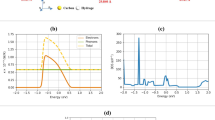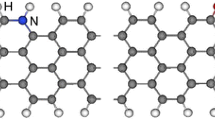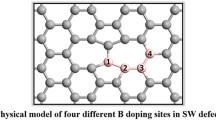Abstract
Density Functional-based Tight-Binding coupled with Non-Equilibrium Green Function calculations is used to study the influence of the boron substitutional doping in the Stone–Wales defect on the structural, electronic, and thermoelectric properties of armchair graphene nanoribbons (AGNRs). The cohesive energies and the defect formation energy of all doped structures are estimated in terms of total energies, and it is also shown that the impurity site plays a part in controlling the characteristics of structures where some sites are most energetically favorable. The enhanced scattering at the boundaries will reduce thermal conductivity, the more asymmetry is, the stronger the boundary effect is. Moreover, Stone–Wales defects and boron substitutional doping may increase the scattering of phonons and thus reduce thermal conductivity. It is noted with boron substitution, a complete electron backscattering area is created in doped structures, and the specific placement of that is determined by the doping sites. We discussed the electron and phonon transport characteristics of doped AGNRs. The results propose that substitutional doping play a significant role in altering the thermoelectric properties of AGNRs with topological defects at specific doping locations, providing a roadmap for the synthesis and design of custom-made AGNRs for specific thermoelectricboundary effect is. Moreover, Stone–Wales defects and boron substitutional doping may increase the scattering of phonons and thus reduce thermal conductivity. It is noted with boron substitution, a complete electron backscattering area is created in doped structures, and the specific placement of that is determined by the doping sites. We discussed the electron and phonon transport characteristics of doped AGNRs. The results propose that substitutional doping play a significant role in altering the thermoelectric properties of AGNRs with topological defects at specific doping locations, providing a roadmap for the synthesis and design of custom-made AGNRs for applications.
Graphical abstract

Schematic of the thermoelectric device based on (a) pristine AGNRs and (b) AGNRs-SW defect






Similar content being viewed by others
Availability of data and materials
Data sharing is not relevant to this article since no new data were produced or analyzed in this investigation.
References
L.E. Bell, Cooling, heating, generating power, and recovering waste heat with thermoelectric systems. Science 321(5895), 1457–1461 (2008)
C.B. Vining, An inconvenient truth about thermoelectrics. Nat. Mater. 8(2), 83–85 (2009)
M. Paulsson, S. Datta, Thermoelectric effect in molecular electronics. Phys. Rev. B 67(24), 241403 (2003)
P. Dollfus, V.H. Nguyen, J. Saint-Martin, Thermoelectric effects in graphene nanostructures. J. Phys. Condens. Matter 27(13), 133204 (2015)
L. Liang, E. Cruz-Silva, E.C. Girao, V. Meunier, Enhanced thermoelectric figure of merit in assembled graphene nanoribbons. Phys. Rev. B 86(11), 115438 (2012)
K.K. Saha, T. Markussen, K.S. Thygesen, B.K. Nikolić, Multiterminal single-molecule–graphene-nanoribbon junctions with the thermoelectric figure of merit optimized via evanescent mode transport and gate voltage. Phys. Rev. B 84(4), 041412 (2011)
F. Mazzamuto et al., Enhanced thermoelectric properties in graphene nanoribbons by resonant tunneling of electrons. Phys. Rev. B 83(23), 235426 (2011)
Y.-N. Peng et al., An efficient mechanism for enhancing the thermoelectricity of twin graphene nanoribbons by introducing defects. Phys. E 122, 114160 (2020)
S. Ramezani Akbarabadi, M. Madadi Asl, Impurity substitution enhances thermoelectric figure of merit in zigzag graphene nanoribbons. Adv. Condens. Matter Phys. 2021, 1 (2021)
Y. Anno, Y. Imakita, K. Takei, S. Akita, T. Arie, Enhancement of graphene thermoelectric performance through defect engineering. 2D Materials 4(2), 025019 (2017)
T.A. Amollo, G.T. Mola, M. Kirui, V.O. Nyamori, Graphene for thermoelectric applications: prospects and challenges. Crit. Rev. Solid State Mater. Sci. 43(2), 133–157 (2018)
J. Cai et al., Atomically precise bottom-up fabrication of graphene nanoribbons. Nature 466(7305), 470–473 (2010)
H. Zeng, J. Zhao, J. Wei, H. Hu, Effect of N doping and Stone-Wales defects on the electronic properties of graphene nanoribbons. Eur. Phys. J. B. 79(3), 335–340 (2011)
S. Hashemi, R. Faez, G. Darvish, Computational study of spin caloritronics in a pristine and defective antimonene nanoribbon. Phys. E 120, 114083 (2020)
S. Chowdhury et al., A real-space study of random extended defects in solids: application to disordered Stone-Wales defects in graphene. Phys. E 61, 191–197 (2014)
S. Chowdhury, D. Jana, A. Mookerjee, Conductance of disordered graphene sheets: a real space approach. Phys. E 74, 347–354 (2015)
X. Wang et al., N-doping of graphene through electrothermal reactions with ammonia. Science 324(5928), 768–771 (2009)
A.E. Senturk, A.S. Oktem, A.E.S. Konukman, The influences of boron doping in various defect sites on the thermo-mechanical properties of armchair graphene nanoribbons. Eur. Phys. J. B. 93, 1–10 (2020)
F. Banhart, J. Kotakoski, A.V. Krasheninnikov, Structural defects in graphene. ACS Nano 5(1), 26–41 (2011)
W. Zeng et al., Defect-engineered reduced graphene oxide sheets with high electric conductivity and controlled thermal conductivity for soft and flexible wearable thermoelectric generators. Nano Energy 54, 163–174 (2018)
M.A. Bazrafshan, F. Khoeini, Tuning phononic and electronic contributions of thermoelectric in defected S-shape graphene nanoribbons. Sci. Rep. 12(1), 1–13 (2022)
W. Lee, G. Lim, S.H. Ko, Significant thermoelectric conversion efficiency enhancement of single layer graphene with substitutional silicon dopants. Nano Energy 87, 106188 (2021)
C. Gayner et al., Enhanced thermoelectric performance of PbSe-graphene nanocomposite manufactured with acoustic cavitation induced defects. Nano Energy 94, 106943 (2022)
Z. Gholami, F. Khoeini, Vacancy tuned thermoelectric properties and high spin filtering performance in graphene/silicene heterostructures. Sci. Rep. 11(1), 1–14 (2021)
J.C. Meyer, C. Kisielowski, R. Erni, M.D. Rossell, M. Crommie, A. Zettl, Direct imaging of lattice atoms and topological defects in graphene membranes. Nano Lett. 8(11), 3582–3586 (2008)
R. D’Souza, S. Mukherjee, Enhancement of thermoelectric figure-of-merit of graphene upon BN-doping and sample length reduction. J. Appl. Phys. 124(12), 124301 (2018)
R. D’Souza, S. Mukherjee, Thermoelectric transport in graphene/h-BN/graphene heterostructures: a computational study. Phys. E 81, 96–101 (2016)
M. Brandbyge, J.-L. Mozos, P. Ordejón, J. Taylor, K. Stokbro, Density-functional method for nonequilibrium electron transport. Phys. Rev. B 65(16), 165401 (2002)
M. Büttiker, Y. Imry, R. Landauer, S. Pinhas, Generalized many-channel conductance formula with application to small rings. Phys. Rev. B 31(10), 6207 (1985)
A. Arab, Q. Li, Anisotropic thermoelectric behavior in armchair and zigzag mono-and fewlayer MoS2 in thermoelectric generator applications. Sci. Rep. 5(1), 1–12 (2015)
W.J. Evans, L. Hu, P. Keblinski, Thermal conductivity of graphene ribbons from equilibrium molecular dynamics: Effect of ribbon width, edge roughness, and hydrogen termination. Appl. Phys. Lett. 96(20), 203112 (2010)
S. Ghosh, S. Harish, M. Ohtaki, B.B. Saha, Thermoelectric figure of merit enhancement in cement composites with graphene and transition metal oxides. Mater. Today Energy 18, 100492 (2020)
Acknowledgements
We thank the Iraqi Ministry of Higher Education and Scientific Research for its support in scientific researches through Iraqi Virtual Science Library (IVSL).
Funding
This study received no particular support from governmental, commercial, or not-for-profit funding entities.
Author information
Authors and Affiliations
Contributions
All authors contributed to the study conception and design. Material preparation, computations, data collection, and analysis were performed by FNA. ABA verified the analytical methods and supervised the findings of this work. The first draft of the manuscript was written by FNA. All authors discussed, read, and contributed to the results to and approved the final manuscript.
Corresponding author
Ethics declarations
Conflict of interest
The authors declare that they have no conflict of interest.
Ethical approval
Ethical approval shows that the researcher followed research ethics. Participants need to understand who has access to and uses their data.
Consent to participate
I understand that all information I provide for this study will be treated confidentially.
Consent for publication
I voluntarily agree to take part in this study. I understand I will receive a copy of this consent form. I understand that photographs (audio/video recordings) may be taken during the study. I consent to the use of my photograph (audio/video) in presentations related to this study.
Research data
No data were used for the research described in the article.
Rights and permissions
Springer Nature or its licensor (e.g. a society or other partner) holds exclusive rights to this article under a publishing agreement with the author(s) or other rightsholder(s); author self-archiving of the accepted manuscript version of this article is solely governed by the terms of such publishing agreement and applicable law.
About this article
Cite this article
Ajeel, F.N., Ahmed, A.B. Influence of the boron doping and Stone–Wales defects on the thermoelectric performance of graphene nanoribbons. Eur. Phys. J. B 96, 127 (2023). https://doi.org/10.1140/epjb/s10051-023-00597-w
Received:
Accepted:
Published:
DOI: https://doi.org/10.1140/epjb/s10051-023-00597-w




